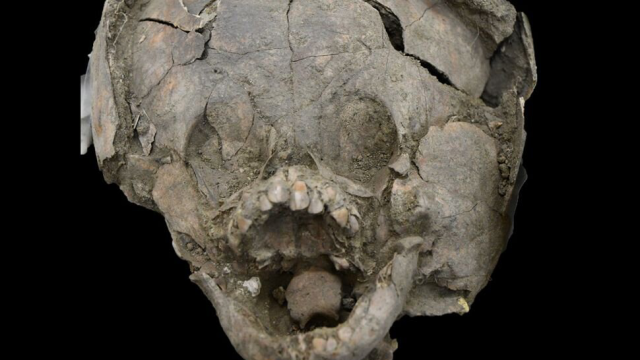Archaeologists in Ecuador have uncovered evidence of a previously undocumented funeral ritual, in which the heads of recently deceased infants were adorned with the skulls of other children. Scientists can only speculate as to the reasons why.
The new study, published in November in Latin American Antiquity, is understatedly titled “Unique Infant Mortuary Ritual at Salango, Ecuador, 100 BC.”
Unique. Um, yeah, you could certainly describe it as that. Archaeologists have previously documented ancient burials in which human body parts, including heads, played an important ritual purpose (see here, here, and here), but this discovery—in which children’s skulls were used as helmets for dead infants—is unlike anything ever seen before.
This discovery was made at the Salango archaeological dig along the central coast of Ecuador in South America. A pair of burial mounds, dated to around 2,100 years old and belonging to the Guangala people, were excavated between 2014 and 2016. A total of 11 individuals were found buried in the mounds, the most extraordinary of which were two infants adorned with “helmets” or “mortuary headgear,” as termed by the researchers in the study, that were fashioned from the brain case, or cranial vault, of juveniles. Other bits of skull were placed around the heads of the dead infants, which was presumably done at the time of burial.
Anthropologist Sara Juengst, the first author of the study and an assistant professor at the University of North Carolina at Charlotte, said she and her colleagues were “pretty surprised” by the discovery, though she wasn’t present during the original dig, led by study co-author Richard Lunniss, an archaeologist from Universidad Técnica de Manabí in Ecuador.
During the excavations, Luniss “quickly recognised that there were two layers of skull,” so to help with the preservation, he removed the burials with the surrounding chunks of soil intact, Juengst told Gizmodo in an email. “When I analysed the remains in 2017, we actually finished excavating the remains in the lab, which led to the more detailed discoveries about age of the primary individuals and the extra crania,” she said.
None of the graves were disturbed prior to excavations, according to the paper, and all skulls examined in the study were reasonably preserved, exhibiting the normal signs of degradation. The outer helmet-like skulls featured straight edges, which suggests they were deliberately cut, though only one cut mark was found, according to Juengst.
The first infant, designated burial 370, was around 18 months old at the time of death and was fitted with a skull belonging to a juvenile between the ages of 4 and 12 years old. The second infant, burial 339, was around 6 to 9 months at the time of death and fitted with a cranium belonging to a child between the ages of 2 and 12 years old. Neither of the infants exhibited signs of physical trauma, and their sex could not be determined. Both of the juvenile skulls were “still fleshed” when secured to the infants’ heads, according to the paper. In both cases, the helmet skulls were fitted tightly to the infants’ heads, and in the case of burial 370, the outer skull was positioned such that the infant’s face “looked through and out of the cranial vault,” according to the paper.
That both outer skulls were made from the crania of juveniles struck Juengst as being “particularly odd.” Skulls belonging to adults “were regularly manipulated in different ways in the pre-hispanic Andes, but child skulls are less commonly involved,” she told Gizmodo.
The scientists weren’t able to locate the bodies of the juveniles, nor were they able to fully understand the exact nature of this apparent funeral ritual, which included the depositing of items around the bodies, such as the extra bits of skull, stone figurines, and other grave goods. The helmet skulls and bits of crania may have served the purpose of protecting and/or “further empowering” the infants in the afterlife, who were perceived as having souls that were “pre-social” and “wild,” according to the paper.
In other ritual contexts, children were perceived by many South American groups as having special importance, such as a 15th-century site in Peru containing the sacrificed remains of 137 children. In this new case, no evidence exists that the infants were sacrificed, “but clearly children were significant in moments of crisis,” said Juengst. At the Salango site, the burial mounds were found above a layer of volcanic ash, which may be linked to an eruption in the highlands and a consequent food shortage, though more research will be required to bolster these speculations.
[referenced url=” thumb=” title=” excerpt=”]
And while the placing of skulls on the heads of infants might seem barbaric or grotesque, Juengst said we need to cast aside our modern biases.
“For modern people who are horrified by these findings, I would remind them that our conception of death is based in our modern medical, religious, and philosophical views,” Juengst told Gizmodo. “Guangala people had their own conception of the cosmos and what happens after death, and the significance of human bodies. While we are usually averse to handling dead bodies, there is a lot of precedent around the world of cultures who don’t have this aversion—we need to think about things in their own context as much as possible and try to keep our own prejudices or ideas about ‘right/wrong’ out of the analysis.”
Indeed, the reasons for this elaborate funeral ritual are likely more sophisticated and perhaps even more enlightened than they appear. As Juengst aptly points out, we need to stay open minded about ancient people and their motivations.
